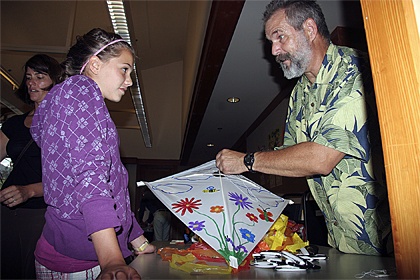Dan Schwenk took an assortment of household items — kitchen trash bags, wooden dowels and sticker labels — and taught a group of Valley children how to catch the summer wind.
Schwenk, a kitemaking instructor with the School of the Wind, appeared at North Bend Library last month for a class on kites.
His kitchen-bag kites “are great little flyers,” said Schwenk, who also brought a selection of vintage Chinese, Japanese and Korean kites to wow the children. Also on display was a World War II U.S. Navy target practice kite, painted with a Zero fighter, and a huge compound Delta-Conyne kite.
“It pulls like a pony,” Schwenk said, yet “in a light wind, it can be held by a child.”
But what really engrossed the children was decorating their new kites.
Flowers and stars, birds and bugs, firebreathing beasts and giant eyes took shape on the diamond-shaped surfaces.
For Karlie Hurley, 12, of North Bend, as for many of the children present, this was their first kite.
“It’s pretty cool,” Hurley said. “It’s pretty easy, too.”
Schwenk has taught kitemaking for 30 years. He’s made hundreds of kites and seen hundreds of smiles.
“I don’t know what the magic is, but if a kid is running with a kite in the air behind them, their heart is totally connected to the kite,” he said. “If they’ve made the kite themselves, and it flies, something really strong happens. The kid can get hooked into a hobby or interest that can last a lifetime.”
Kite-making has always been a passion for Schwenk. But recently, after he was laid off from his biotech job, it became more than just a sideline — it’s a career. He gives classes at company parties, Girl Scout meetings, and lots of libraries.
“I’m a ham,” Schwenk said. “I like performing.”
What draws him to kites is being in touch with the wind.
“If I’m out there alone on the beach with a kite, and it’s up there doing what it’s supposed to, I can just lay back there and watch it,” Schwenk said.
Many of the children planned to fly their new kites the same day. All they need is proper spot to fly them.
“Almost any school that has a football field or a playground, that’s a good place,” Schwenk said.



